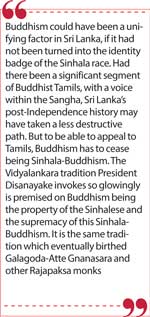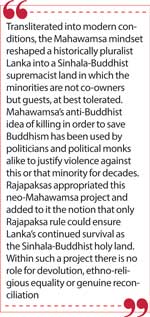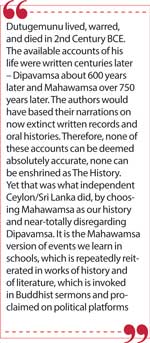Wednesday Nov 05, 2025
Wednesday Nov 05, 2025
Wednesday, 5 November 2025 00:22 - - {{hitsCtrl.values.hits}}

Mahawamsa was the go-to text for those who justified the politicisation of Buddhism
“The future is in the Past.” – An epigram on the official Mahawamsa website
By Tisaranee Gunasekara
 For King Dutugemunu there is no rest. With distressing regularity, he is summoned in the service of an ambitious politician, a divisive policy or a violent act. The latest instance of necromancy occurred when monk Galagoda-Atte Gnanasara visited Mahinda Rajapaksa in Medamulana, the ‘homeless’ ex-president.
For King Dutugemunu there is no rest. With distressing regularity, he is summoned in the service of an ambitious politician, a divisive policy or a violent act. The latest instance of necromancy occurred when monk Galagoda-Atte Gnanasara visited Mahinda Rajapaksa in Medamulana, the ‘homeless’ ex-president.
The NPP promised to scrap the Presidential Entitlements Act in its manifesto, and forgot it until the party’s setback at the May 2025 Local Government election. In June, the legal draughtsman was told to prepare the necessary documents. The SLPP’s administrative secretary and Mahinda Rajapaksa’s media secretary led the legal challenge to the resultant Bill. The Supreme Court rejected the petitions and the Bill was enacted in September.
Maithripala Sirisena left his official residence quietly; Chandrika Bandaranaike Kumaratunga asked for a three-month-grace-period (due to an ailment) and is now in the process of leaving. Both acted with commendable dignity. (Neither Gotabaya Rajapaksa nor Ranil Wickremesinghe were occupying their official residences).
Mahinda Rajapaksa, his family, and his party turned the issue into a melodrama. It was as if this aged leader was illegally and violently thrown out from the house of his ancestors, the home of a lifetime, his sole shelter. The same way his Government treated the residents of Mews Street Colombo 2, who were informed on 4 May 2010 that they will have to leave their ancestral homes within four days. On 8 May, 107 residents (24 of them children) living in 17 houses were violently evicted in a military operation which pitted 2,500 armed servicemen in full riot gear against unarmed men, women and children.
According to the Government, 1.5 million Lankan families do not own a house currently. The Justice Minister recently said that if eviction orders are implemented, about a third of Colombo’s population would be homeless (that is over 300,000 people). Unfortunately, neither the Government nor the Opposition seems overly concerned about this burgeoning socio-economic, political, and human crisis (the deprioritising of housing after the assassination of President Premadasa led to this situation).
This indifference is in stark contrast to the grand fuss that is being made about Mahinda Rajapaksa losing his official residence. The SLPP is busy facilitating/organising tours to Medamulana. Amongst the visitors were Galagoda-Atte Gnanasara and a group of Bodu Bala Sena monks. Addressing the media afterwards, the progenitor of Aluthgama and Digana anti-Muslim riots said that depriving Mahinda Rajapaksa of his official residence “was an act of revenge by the government on behalf of the Tamil Diaspora.” He then summoned Dutugemunu, equating the ancient king’s defeat of Elara with Mahinda Rajapaksa’s defeat of the ‘barbaric’ separatist forces. “I think the heart of this elderly president is being slashed to make those separatist forces happy,” he concluded.
 According to Mahawamsa, Dutugemunu lived and reined the 2nd Century BCE. More than 2,000 years later, his life, his battles, his thinking, as narrated in Mahawamsa, continue to shape Lankan politics. His belief of an existential threat to the Sinhala-Buddhist land and his epic battle to it constitute the trap modern Lankan politics is caught in.
According to Mahawamsa, Dutugemunu lived and reined the 2nd Century BCE. More than 2,000 years later, his life, his battles, his thinking, as narrated in Mahawamsa, continue to shape Lankan politics. His belief of an existential threat to the Sinhala-Buddhist land and his epic battle to it constitute the trap modern Lankan politics is caught in.
Histories we choose
The oldest extant chronicle of Lankan history is not Mahawamsa. It is Dipawamsa, written at least 150 years before Mahawamsa. Mahawamsa, full of myths, impossibilities, and exaggerations, reads more like historical novel than a record of history. The older Dipawamsa which uses myths and exaggerations sparingly, reads far more like a historical record.
The way Dipawamsa and Mahawamsa covers the Dutugemunu story cannot be different. Mahawamsa, while extolling Elara’s virtues, emphasises his Tamilness and his non-Buddhistness. Dipawamsa does neither. This is how Dipawamsa describes Elara (according to a new Sinhala translation by Prasad Fonseka): “A person called Elara killed a king called Asela and reigned righteously for 44 years” (translation mine; the 1879 translation by Hermann Oldenberg reads, “A prince, Elara by name, having killed Asela, reigned righteously forty-four years”).
According to Dipawamsa, the Elara-Dutugemunu battle had nothing to do with race or religion. Dutugemunu killed Elara and “united the clan.” Nothing about waging a war for the “establishment of the doctrine of Sambuddha,” as Mahawamsa claims. More pertinently, nothing about arhants (monks who had attained Arhathood) justifying the murder of millions of ‘unbelievers’ in the name of religion because they were “men of evil life… not more to be esteemed than beasts…” as Mahawamsa phrases it.
Not only is this anti-Buddhist concept of waging war and killing people to save Buddhism absent in Dipawamsa. A totally different version of the Dutugemunu’s post-war reaction is given in Sumangala-Vilasini, Buddhaghosa thero’s 5th Century CE commentary on the Digha Nikaya. Prof. Jotiya Dhirasekara highlights this story in his Critical Studies in the Early History of Buddhism in Sri Lanka. Dutugemunu, “having conquered thirty-two Tamil rulers, was anointed as king in Anuradhapura and on account of the joy he gained, he could not sleep for a month. Thereupon he informed the community of monks that he could not sleep. (They replied) If that were so, your majesty, this morning itself you observe Uposatha. He did take upon himself the observance of the Uposatha. The Sangha sent eight Ābhidhammika monks, asking them to go and chant the Citta-yamaka selection (of the Samyutta Nikaya). They went and, asking the king to lie down, commenced the recital. The king, as he listened to the recital, fell asleep.”
 Dutugemunu lived, warred, and died in 2nd Century BCE. The available accounts of his life were written centuries later – Dipavamsa about 600 years later and Mahawamsa over 750 years later. The authors would have based their narrations on now extinct written records and oral histories. Therefore, none of these accounts can be deemed absolutely accurate, none can be enshrined as The History. Yet that was what independent Ceylon/Sri Lanka did, by choosing Mahawamsa as our history and near-totally disregarding Dipavamsa. It is the Mahawamsa version of events we learn in schools, which is repeatedly reiterated in works of history and of literature, which is invoked in Buddhist sermons and proclaimed on political platforms.
Dutugemunu lived, warred, and died in 2nd Century BCE. The available accounts of his life were written centuries later – Dipavamsa about 600 years later and Mahawamsa over 750 years later. The authors would have based their narrations on now extinct written records and oral histories. Therefore, none of these accounts can be deemed absolutely accurate, none can be enshrined as The History. Yet that was what independent Ceylon/Sri Lanka did, by choosing Mahawamsa as our history and near-totally disregarding Dipavamsa. It is the Mahawamsa version of events we learn in schools, which is repeatedly reiterated in works of history and of literature, which is invoked in Buddhist sermons and proclaimed on political platforms.
Had Ceylon/Sri Lanka adopted the Dipawamsa version or at least gave equal prominence to both versions, our modern history might have taken a different – arguably a less bloody – turn. For Dipavamsa’s origin story is also different from Mahawamsa. According to it, Lanka became known as Sinhala “because of a person named Sinha…” Not a lion with a mane and a tail, but a man. “The daughter of the Vanga king cohabited with Sinha who lived in the jungle and gave birth to two brothers. Sinhabahu and Seevali were comely male children. Mother was named Susima and father was named Sinha.” In Mahawamsa, the princess cohabited with a real lion, gave birth to a son and a daughter. Son, Sinhabahu killed the father and married the sister. Dipawamsa, unlike Mahawamsa, does not make any mention of the Buddha proclaiming that his Dhamma will survive in its pristine form only in Lanka.
Embracing Mahawamsa and shoving Dipawamsa to obscurity, enabled the creation of the myth of Lanka as the holy land of (Sinhala) Buddhism in relentless contestation with alien invaders for Sinhala-Buddhist Lebensraum (living space) as well as the concept of ‘sinless/meritorious war’ (waged for the protection of Buddhism, against enemies who are ‘unbelievers and men of evil life’). Transliterated into modern conditions, the Mahawamsa mindset reshaped a historically pluralist Lanka into a Sinhala-Buddhist supremacist land in which the minorities are not co-owners but guests, at best tolerated. Mahawamsa’s anti-Buddhist idea of killing in order to save Buddhism has been used by politicians and political monks alike to justify violence against this or that minority for decades. Rajapaksas appropriated this neo-Mahawamsa project and added to it the notion that only Rajapaksa rule could ensure Lanka’s continued survival as the Sinhala-Buddhist holy land. Within such a project there is no role for devolution, ethno-religious equality or genuine reconciliation.
Commenting on three 1991 books on Christopher Columbus, American historian and author concludes, “There is a positive need not to know about Columbus – including a need not to know how little there is to know” (https://www.nybooks.com/articles/1991/11/21/man-of-the-year/). This is true of so many historical figures, including Dutugemunu. Obviously, both admirers and detractors were and are willing to start and stop with Mahawamsa version of events, the former understandably, the latter inexplicably.
Currently, Sri Lanka is experiencing a rare period of ethno-religious non-conflict. The invoking of Dutugemunu by Galagoda-Atte Gnanasara points to the possibility of sundering the current civil peace using Mahawamsa.
The role of monks
In his History of Buddhism in Ceylon, Walpola Rahula thero describes the ties between state/king and the Sangha in ancient Lanka. The Sangha “used their influence over the masses to support the king who in return looked after their interests. It was a matter of mutual understanding, though it was never explicitly stated. The king found a powerful means of propaganda in the Sangha who had close contact with the people, and had great influence over them. Hence we find kings, who had committed heinous crimes, honouring the Sangha and sending them around the country in order to influence the people in their favour… It was easy for the king to rule if the people were religious… religions are always expected to uphold the established order and discourage innovations and revolutions…Whatever the kings did for Sangha was therefore amply rewarded.” This of course was a far cry from what the Buddha taught (as per the Pali canon). “Sasana constituted a fully-fledged state department,” Rahula concludes.
 The identical term was used by Prime Minister DS Senanayake when he refused early requests by leading monks to make Buddhism the state religion of independent Ceylon; doing so, he argued, would be to “reduce this sublime creed to the level of a state authority” (Religion and Politics in Sri Lanka – Urmila Phadnis). During the debate between Vidyodaya and Vidyalankara pirivenas about the role of monks in independent Ceylon, Mr Senanayake took the stand that monks should not involve themselves in politics but focus on the spiritual wellbeing of the people.
The identical term was used by Prime Minister DS Senanayake when he refused early requests by leading monks to make Buddhism the state religion of independent Ceylon; doing so, he argued, would be to “reduce this sublime creed to the level of a state authority” (Religion and Politics in Sri Lanka – Urmila Phadnis). During the debate between Vidyodaya and Vidyalankara pirivenas about the role of monks in independent Ceylon, Mr Senanayake took the stand that monks should not involve themselves in politics but focus on the spiritual wellbeing of the people.
Vidyodaya Pirivena lost the debate. SWRD Bandaranaike (who was hailed as Dutugemunu in 1956) formalised the advent of monks into politics by making them the first pillar of his Pancha Maha Balavegaya.
Mahawamsa was the go-to text for those who justified the politicisation of Buddhism. According to Mahawamsa some monks gave up robes to join Dutugemunu’s army while 500 monks accompanied the army. Once again, Dipawamsa makes no mention of any of this, even though it does mention Dutugemunu’s 10 warriors and Kandula, the elephant. Mahawamsa’s version became the first justification of the persistent myth of monks as the guardian-deities (mura-dewathawo) of the (Sinhala) nation rather than spiritual guides committed to teaching Dhamma to lay people.
During his speech at a ceremony to mark the 150th anniversary of the founding of the Vidyalankara Pirivena, President Anura Kumara Disanayake mentioned that seminal debate and indicated clearly that he stood on the Vidyalankara side of the divide. So did the old left, but they had no idea how quickly, easily, and seamlessly the Progressive Monk would morph into Patriotic Monk. President Disanayake has no such excuse. He knows how political monks spearheaded the Sinhala Only campaign and sabotaged the two attempts to resolve the language problem it created. He knows how SWRD Bandaranaike’s alliance with monks ended and the role Patriotic Monk played in worsening anti-Tamil hysteria and creating/recreating anti-Muslim and anti-Christian hysteria. Knowing that past, he should realise that the same monks he is appealing to and courting now will move to the Rajapaksa side when politico-electoral tides turn; and help Namal Rajapaksa become the next president by showcasing Tamil/Muslim/Christian enemy as and when necessary.
Contrary to popular myths, Buddhism flourished in South India long after its decline in North India. The teachings of Gautama Buddha are neither tribalistic nor martial. Buddhism could have been a unifying factor in Sri Lanka, if it had not been turned into the identity badge of the Sinhala race. Had there been a significant segment of Buddhist Tamils, with a voice within the Sangha, Sri Lanka’s post-Independence history may have taken a less destructive path. But to be able to appeal to Tamils, Buddhism has to cease being Sinhala-Buddhism. The Vidyalankara tradition President Disanayake invokes so glowingly is premised on Buddhism being the property of the Sinhalese and the supremacy of this Sinhala-Buddhism. It is the same tradition which eventually birthed Galagoda-Atte Gnanasara and other Rajapaksa monks.
As the Dipawamsa shows, we don’t need to be prisoners of Mahawamsa history. It is but one version of events which happened (or didn’t happened) centuries previously. The past (as depicted in the Mahawamsa) doesn’t have to be our future, again and again. What we lack are not choices but leaders with the political will to make them.